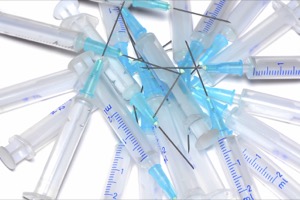
“Can you imagine a 2.8 million pile of dirty syringes?”
That’s the image Dr. James Dunford, the city of San Diego’s emergency medical services director, suggested to a San Diego City Council committee Nov. 12 when he reviewed the city’s Clean Syringe Exchange Program for fiscal year 2015.
Dunford said those dirty needles were safely and discretely exchanged by IV users at two mobile units instead of dumpsters, beaches, parks, trash cans or playgrounds. The purpose is to stop HIV/AIDS and Hepatitis C infections.
“Preventing the spread of HIV is so important,” said Third District Councilmember Todd Gloria. “People just don’t have a way to (dispose) of dirty needles.”
Dunford told the Public Safety & Livable Neighborhoods Committee that San Diego is the third highest city in the state with HIV infections. Injection drug use is the highest cause of Hepatitis C infections and the second highest cause of AIDS.
People must turn in dirty needles in order to get up to 30 clean needles which are distributed by the program’s sponsor, the Family Health Centers of San Diego. In 2016, the program will increase to 50 clean needles to clients.
It is not just addicts who turn in dirty needles. Sometimes relatives of addicts turn in large amounts of used syringes, often after a death. Occasionally diabetics have turned in needles.
The city does not pay for the program other than awarding $75,000 in a community development block grant. Previous private funders include the Human Dignity Foundation, AIDS United, Comer Foundation and MAC AIDS Foundation.
In 2015, 376,417 dirty syringes were turned in and 306,074 clean ones were exchanged, leaving a difference of 70,343. The 2.8 million figure Dunford cited is the amount received since the program began in 2002.
The mobile unit collects syringes Thursday evening for three hours downtown and also on Friday mornings in North Park for three hours. Gloria said some residents complained years ago, but “we don’t have those complaints anymore.”
Dunford’s report said there was 100 percent increase in referrals to a wide variety of services from other agencies, such as detoxification, mental health, substance abuse, HIV, STD, Hepatitis C testing, Medi-Cal, food, housing and clothing.
There were 12,765 client visits, with 12,145 being repeat clients with an identification card in 2015. There were 28,162 referrals because many were given multiple agency referrals. They were also given harm reduction and health kits.
Dunford pointed out how the County Board of Supervisors do not support the program or give any funding, saying AIDS “doesn’t stop at the city limits.”
“I don’t understand why the County refuses to be involved,” said Chairperson Marti Emerald.
Dunford brought up the change of policy that occurred March 25 when Indiana Gov. Mike Pence, a Republican, overrode his own state law when he declared a public health emergency in Scott County after 79 new cases of AIDS were confirmed.
Pence authorized a short term needle exchange program after 71 new cases of AIDS were attributed to IV use of a prescription painkiller in which users shared their needles. Pence told reporters the county usually experiences five new cases of AIDS per year.
“He politically changed his mind,” said Dunford.
Client demographics in 2015 include:
75% male (less than 1% transgender in all of the last five years)
67% white, 15% Hispanic, 6% African American, 12% other
70% unemployed
41% owns/rents; 29% stay at friends; 22% homeless; 8% other
34 is Median age
71% never married; 19% widowed/separated; 9% married; 1% domestic partner
79% high school graduate or more
“Thank you for your dedication to this program,” said Emerald to Dunford and to Tim Fraser of Family Health Centers.
Also present for the report were Councilmembers Myrtle Cole and Chris Cate. There was no vote as this report is a program requirement.











